The following are photos from our gallery day presentation.
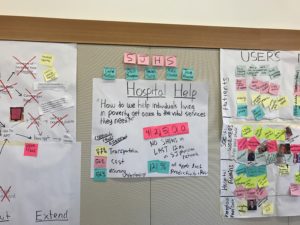
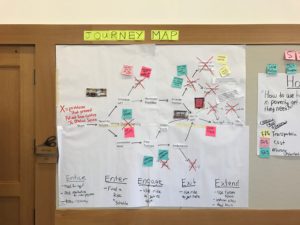
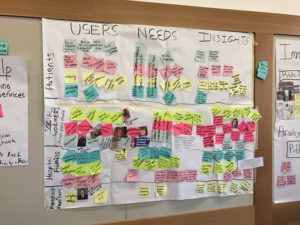
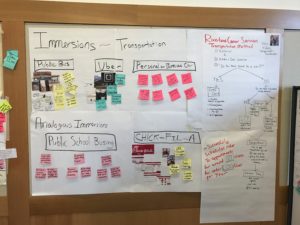
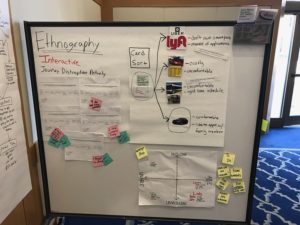
The following are photos from our gallery day presentation.





The 3rd Annual Pi Day 5K/10K
Registration is now open for the Annual Pi Day 5K, hosted by the Association for Women in Science and Society of Schmitt Fellows. Registration is available on the website. It costs $25 ($30 after Friday, March 10) and includes a running shirt and pie and hot cocoa after the race. Aren’t interested in running races? We also need volunteers — sign-up is also on the website — all volunteers get a T-shirt as well! All proceeds go to benefit the Boys and Girls Club running programs at Harrison Primary School in South Bend.
Saturday, March 18; 3:14 p.m. starting outside McCourtney Hall
Our team met with Michelle Peters, the Community Benefit Ministry Officer and Director Community Health and Well-being for Saint Joseph Health System. During gallery day we discussed the research we had conducted, future plans to conduct additional research and begin prototyping, and Michelle offered very insightful feedback for different parts of the project. Her involvement with SJHS has proven a valuable resource as she is very knowledgable about past projects about the same issue. She also is a great resource in terms of understanding the dynamics of funding, an issue we consider to be one of the main obstacles in securing transportation for SJHS’s clients living in poverty. Below are listed a few takeaways from gallery day as well as future plans for our team which we discussed with Michelle.
Main Takeaways:
Further Research/Plans
*Pictures of our team’s gallery day will be provided by other team members.
The Gallery Day was very insightful because we were able to present all of our research to Michelle and then receive valuable feedback in moving forward with our project. We walked Michelle through the different aspects of our collected research starting with our Journey Map and finishing our Analogous Immersions. Michelle seemed to think that we were on the right track to solving the transportation problem and she was impressed to see that we collected research from so many outlooks.
Collectively, our team had three main walkaway points from our research pertaining to finding a solution:
It was very helpful having Michelle come to the Gallery because she was able to create links and provide ideas within our research. Moving forward, we will use all of our collective research to come up with a sustainable solution to the huge transportation problem that exists in South Bend.
Below is photo of the team presenting their research.
 .
.
Gallery day provided a great platform for us to take a step back and discuss at the big takeaways of our ethnographic research. Peter provided valuable perspective and challenging questions as we discussed our findings with him. Below are the major takeaways and gaps in our research that we want to focus on moving forward.
A common theme among the homeless was a struggle with mental health and substance abuse problems. The cause and effect is not always unidirectional; sometimes being homeless causes someone to take up drinking, and sometimes drinking leads someone into homelessness. We need to think more about out who will pay for these services – the state, charities, the city? And even if they were accessible, would our population of homeless people be willing to use them?
2. Cultural differences that can become a barrier for exiting homelessness.
Many homeless grew up in poverty and this reflects in their attitudes and behavior. However, employers have a bias towards people who understand the middle class cultural script. This disconnect can be part of the problem of homeless being unable to get and hold jobs.
3. Idleness during day could be window of opportunity
Most of the homeless have nothing to do in between meals – the soup kitchens close down, and the shelter does not open until after dinner. The good news is that time does not need to be a constraint for homeless people. Maybe we can use this open time in their day to get them to activities/services that will benefit their health and/or help them exit homelessness.
I think it would be valuable for us to fully understand the services that CFH offers. They are known for having a great program to get people back on their feet, and it’d be great to see what they do firsthand. I also think it would be helpful to talk with some of the homeless that live there and ask about their journey to the shelter. I’d also like to better understand some of the barriers that may keep our population out of the shelter. Finally, I’m interested in where their funding comes from and how they choose to allocate it.
2. Exploring funding options
Who would pay for additional programming for the homeless? The city, state government, churches, charities? I think understanding budget constraints may help provide more guidance for our ideation & potential solutions. Moving forward, I think we should try to talk with the current soup kitchens & CFH to understand where their money comes from, and we should also talk with people involved on the city council.
Great video highlighted in the New York Times Today on retirement:
|
|
Today’s Gallery Day FaceTime call with Pat Keran from Optum went well. It was helpful for us all to come together and synthesize all of the research we have individually done up to this point and also see what each of the other group members have done. It was also good to get Pat Keran up to speed with what we have been considering for this project. Between this synthesis of information and Pat’s excellent input, we were able to brainstorm some ideas at the end of Gallery Day to figure out what other research we should do and to also get a more focused and narrowed idea of what problem we want to attack. One of the big things that Pat mentioned to us is that we should begin to consider a more diverse population of retirees, as the concerns and issues will be vastly different for people in retirement depending upon their socioeconomic background or cultural roots.
What I considered to be Pat’s best piece of advice for us moving forward, is to be conscious that whatever innovative idea we choose to move forward with is personalized, accessible, and engaging. These seem to be the three most important factors when considering a population who, on average, can be considered a bit more stubborn or stuck in their ways and resistant to technology in many cases.
Moving forward, I think that some important secondary research should involve taking Pat’s advice on learning about the needs of a more diverse population of retirees and analyzing patterns that exist across people of multiple backgrounds. We will also need to continue to narrow down our focus on what end of the retirement spectrum we will want to consider. We made good progress today in agreeing that we think want to focus on the earlier end of the spectrum and that the spectrum we are considering should not include age discrimination. Throughout all of our research and during Gallery Day, we have learned and affirmed that age does not necessarily have any relation or importance for where you appear on the spectrum of retirement.
Type: Analogous Immersion – Deciding my college
Stage 1: I knew that I had to get my college right. My sister had just selected her college after a major debate with my parents, where she chose a lower ranked college compared to the others she had been accepted to. She prioritized going to the East Coast, as well as pursuing a path to medical school. I knew that I would have to get this right and make sure I can pick a school that my parents could also support.
Stage 2: I began the college application process by eliminating the ones I knew I didn’t have the academic qualities for. Then I went down the list of the US College News and World Report Rankings and picked out ones that fit my interests: journalism and business. I only considered business because my parents really felt that a business school would better prep me for a career than journalism, so schools like Washington University in St. Louis, Dartmouth, and UCLA were only there to appease my parents. I was really looking at Northwestern (Which I applied Early Decision for), USC, and UC Irvine.
Stage 3: When Northwestern had turned me down, I went back to the drawing board and went through stage 2 again. I wanted to better my chances of being accepted into a college my parents could get behind, so I picked about six more, adding schools like Case Western and Carnegie Mellon to improve my chances, despite not having an in-depth knowledge about them.
I had been talking to my College and Career Counselor about doing a multimedia interview for our student newspaper about her experience as a flight attendant, but she was wondering if she could talk about her experiences as the first cheerleader for Notre Dame in 1969. I then got to learn about Fr. Hesburgh, what Notre Dame meant to the world, and the possibilities that the school offered. I had inadvertently found out about Notre Dame two weeks before the Common App was due.
Stage 4: The common app and supplementary materials were stressful at times, but I felt that I had the right resources to get the job done to the best of my abilities. My parents found a college admissions advisor to help me hone my college choices and review my essays. I had a lot of resources to go through thanks to my school’s College and Career Center, so I knew what scholarships to look for, etc.
Stage 5: After being admitted to my schools, I managed to immediately eliminate schools like USC, UC Irvine, and Pepperdine and ultimately bring it down to Boston College and Notre Dame. I remember eliminating journalism schools entirely, as I felt that I could pursue that interest through student publications. So looking at publications like The Observer and The Heights (Boston College) was high on my priority list. I also wanted to prioritize the quality of the business programs, as well as campus life and
I went into our campus visits giving Notre Dame a 70-30 favorite over Boston College, but after an eventful and hectic trip around South Bend and my sister’s campus tour of BC, I came home feeling 51-49, which began to stress me out. But the day after we returned, the Boston Bombing occurred, which was enough to convince my mom that I should go to Notre Dame. I think I would have chosen ND regardless, but it made the decision a little bit easier on my mom.
Stage 6: I submitted my intent to enroll a week after our visit, and senior year went by quickly for the rest of the year. I had AP exams to worry about, but much of my time after that was spent learning more about my future school. The admissions office sent me packets of information about move in, first year of studies, and campus life that got me even more excited.
Stage 7: As a Notre Dame student, I worked to help make Notre Dame a more common destination for seniors at my school. I’d visit and tell underclassmen what the school had to offer, and why they should apply.
Takeaways: